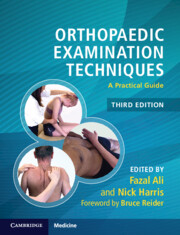Book contents
- Orthopaedic Examination Techniques
- Orthopaedic Examination Techniques
- Copyright page
- Dedication
- Contents
- Contributors
- Preface to 3rd edition
- Foreword to 2nd edition
- Foreword to 3rd edition
- Acknowledgements
- About the authors
- Chapter 1 General Principles of Orthopaedic Clinical Examination
- Chapter 2 Examination of the Shoulder
- Chapter 3 Examination of the Elbow
- Chapter 4 Examination of the Wrist
- Chapter 5 Examination of the Hand
- Chapter 6 Examination of the Peripheral Nerves in the Hand and Upper Limb
- Chapter 7 Examination of the Adult Spine
- Chapter 8 Examination of the Hip
- Chapter 9 Examination of the Knee
- Chapter 10 Examination of the Foot and Ankle
- Chapter 11 Examination of the Brachial Plexus
- Chapter 12 Orthopaedic Examination Techniques in Children
- Chapter 13 Examination of the Spine in Childhood
- Chapter 14 Paediatric Clinical Cases
- Chapter 15 Spine Clinical Cases
- Chapter 16 Upper Limb Clinical Cases
- Chapter 17 Lower Limb Clinical Cases
- Chapter 18 Orthopaedic Cases in the Developing World
- Index
- References
Chapter 6 - Examination of the Peripheral Nerves in the Hand and Upper Limb
Published online by Cambridge University Press: 22 April 2022
- Orthopaedic Examination Techniques
- Orthopaedic Examination Techniques
- Copyright page
- Dedication
- Contents
- Contributors
- Preface to 3rd edition
- Foreword to 2nd edition
- Foreword to 3rd edition
- Acknowledgements
- About the authors
- Chapter 1 General Principles of Orthopaedic Clinical Examination
- Chapter 2 Examination of the Shoulder
- Chapter 3 Examination of the Elbow
- Chapter 4 Examination of the Wrist
- Chapter 5 Examination of the Hand
- Chapter 6 Examination of the Peripheral Nerves in the Hand and Upper Limb
- Chapter 7 Examination of the Adult Spine
- Chapter 8 Examination of the Hip
- Chapter 9 Examination of the Knee
- Chapter 10 Examination of the Foot and Ankle
- Chapter 11 Examination of the Brachial Plexus
- Chapter 12 Orthopaedic Examination Techniques in Children
- Chapter 13 Examination of the Spine in Childhood
- Chapter 14 Paediatric Clinical Cases
- Chapter 15 Spine Clinical Cases
- Chapter 16 Upper Limb Clinical Cases
- Chapter 17 Lower Limb Clinical Cases
- Chapter 18 Orthopaedic Cases in the Developing World
- Index
- References
Summary
A system for examination of the peripheral nerves of the upper limb is described in this chapter. This includes the ulnar, median, radial, axillary and musculocutaneous nerves. The steps are inspection followed by a screen test to decide if the lesion is likely to be radial, median or ulnar. Then the nerve is examined in more detail by testing sensation and movement in relation to that nerve. Provocation tests are performed if necessary. This chapter also describes nerve compression as a result of thoracic outlet syndrome, as this may be a differential diagnosis. In the ‘Advanced corner’ Tinel’s sign and Valleix phenomenon as well as ‘double crush’ are described.
- Type
- Chapter
- Information
- Orthopaedic Examination TechniquesA Practical Guide, pp. 89 - 111Publisher: Cambridge University PressPrint publication year: 2022

